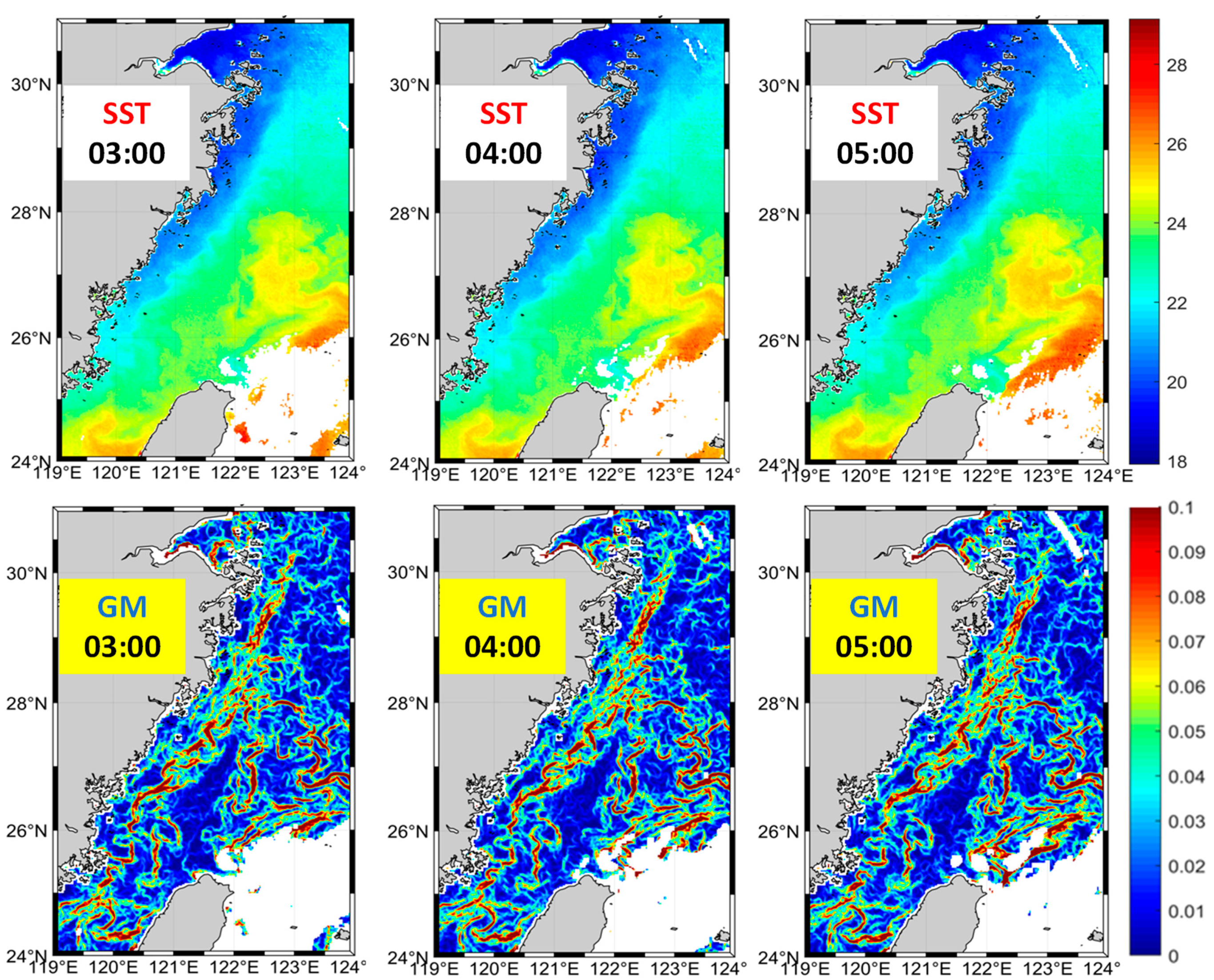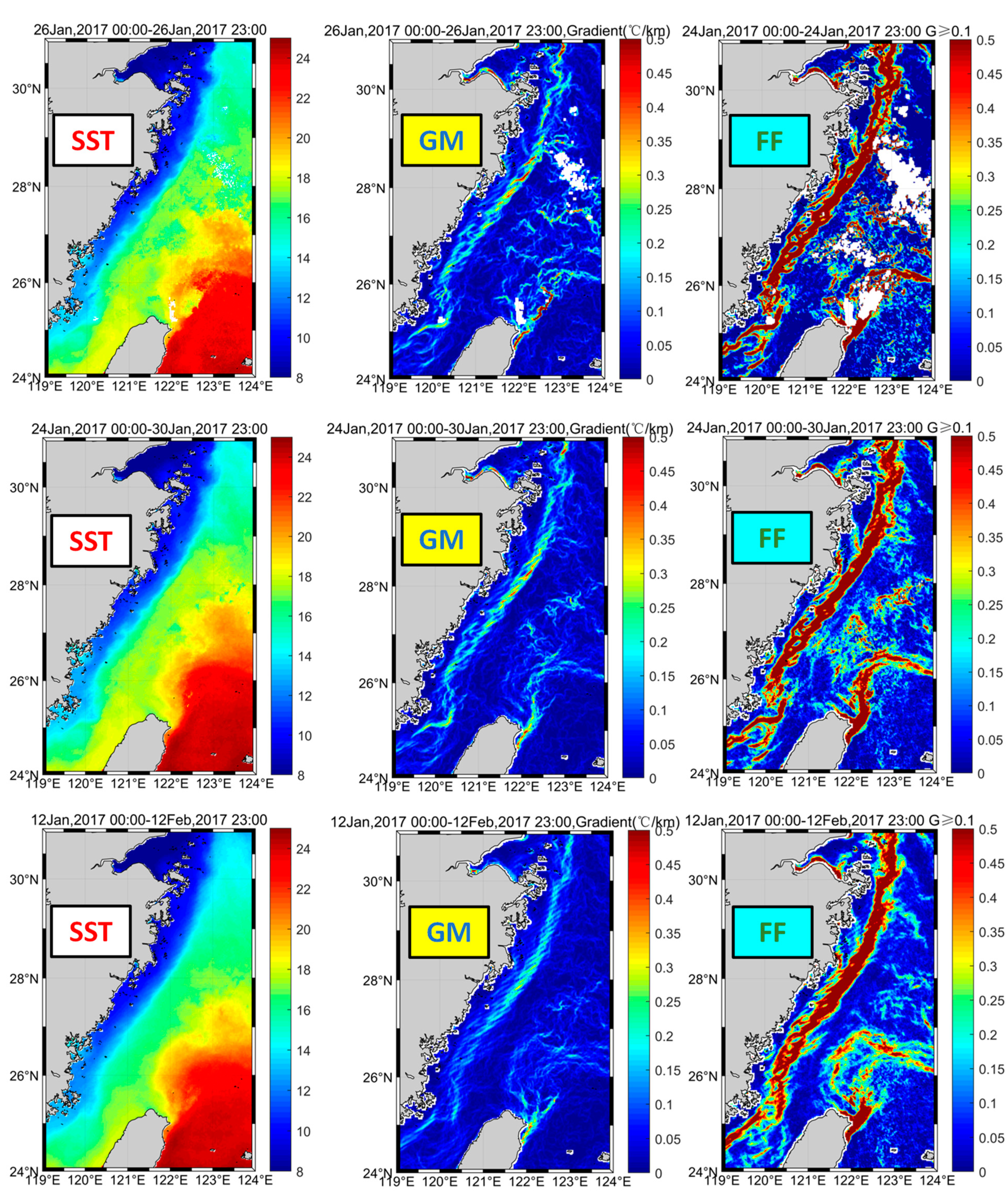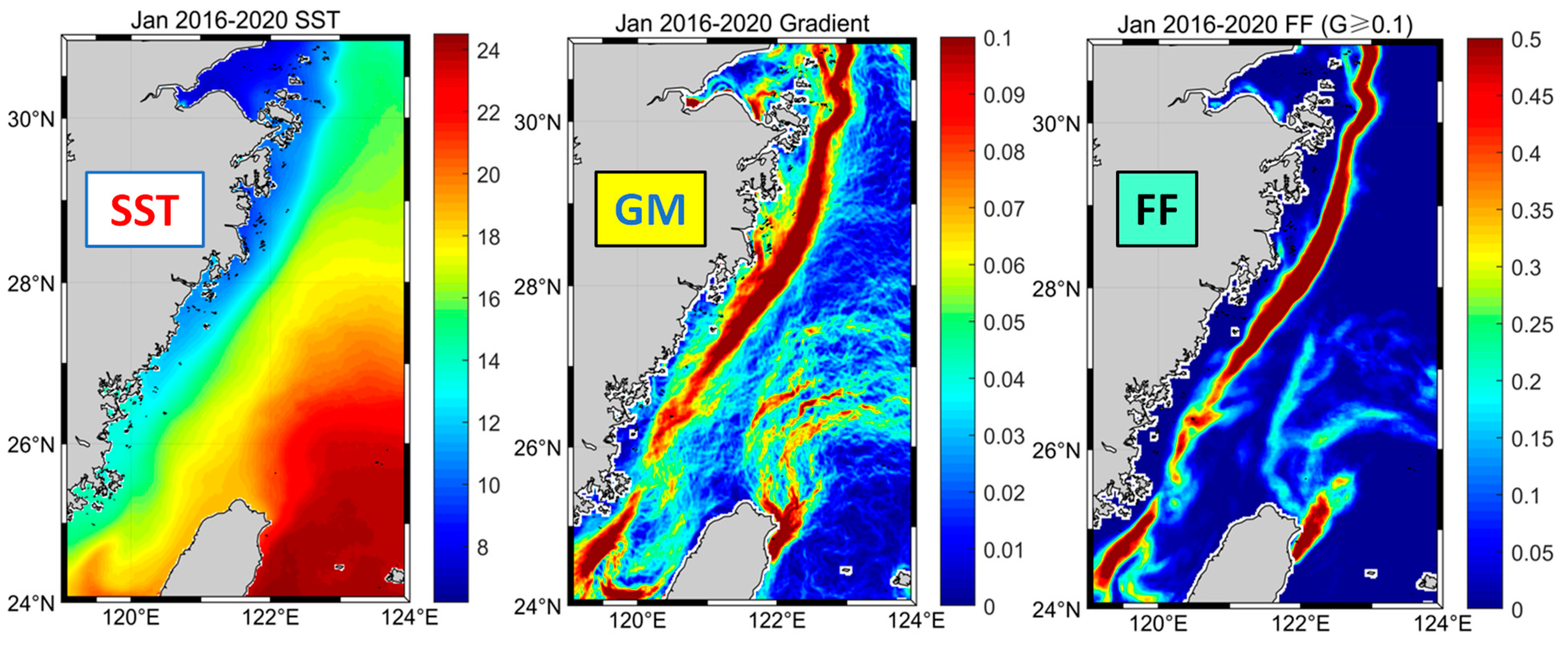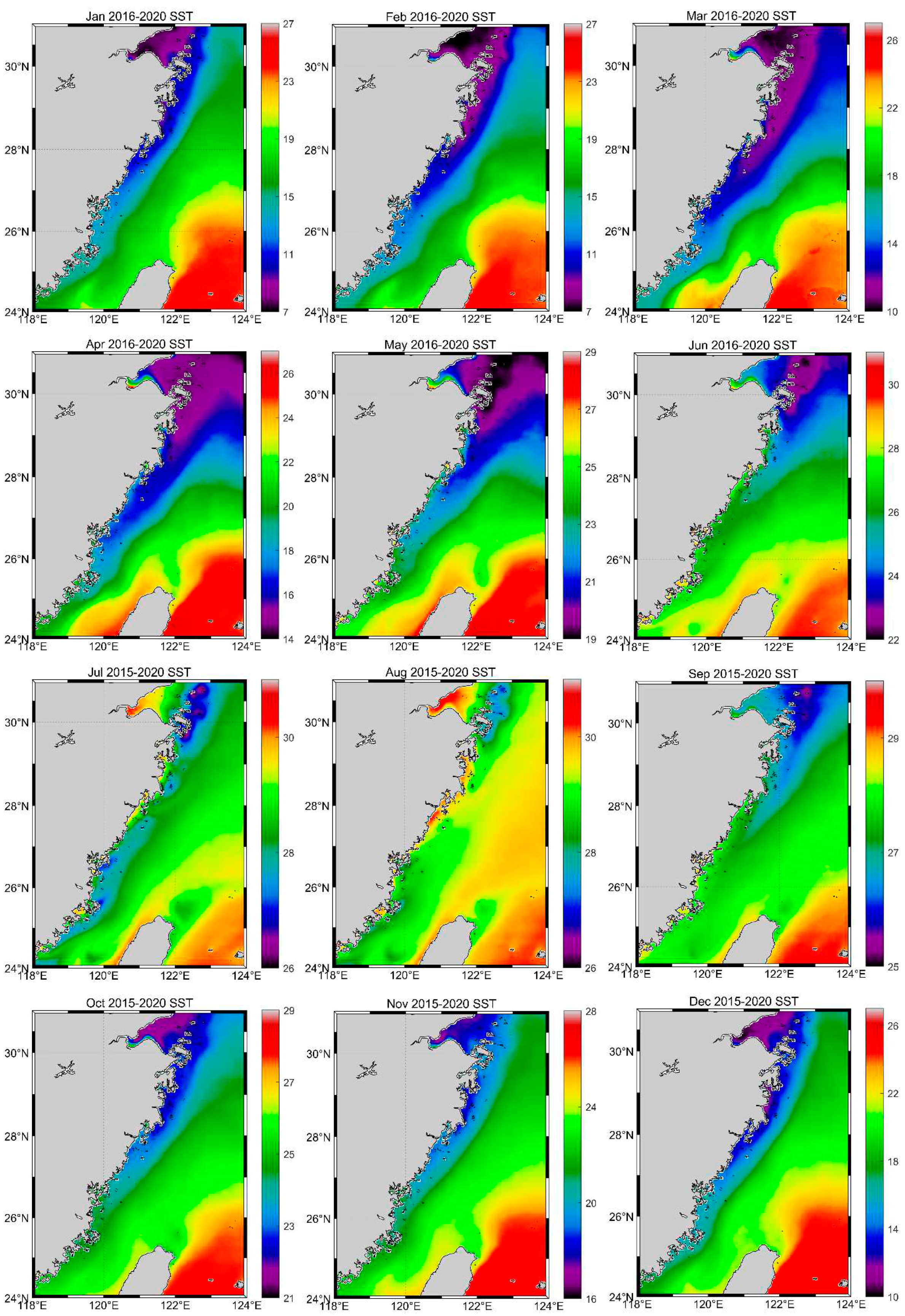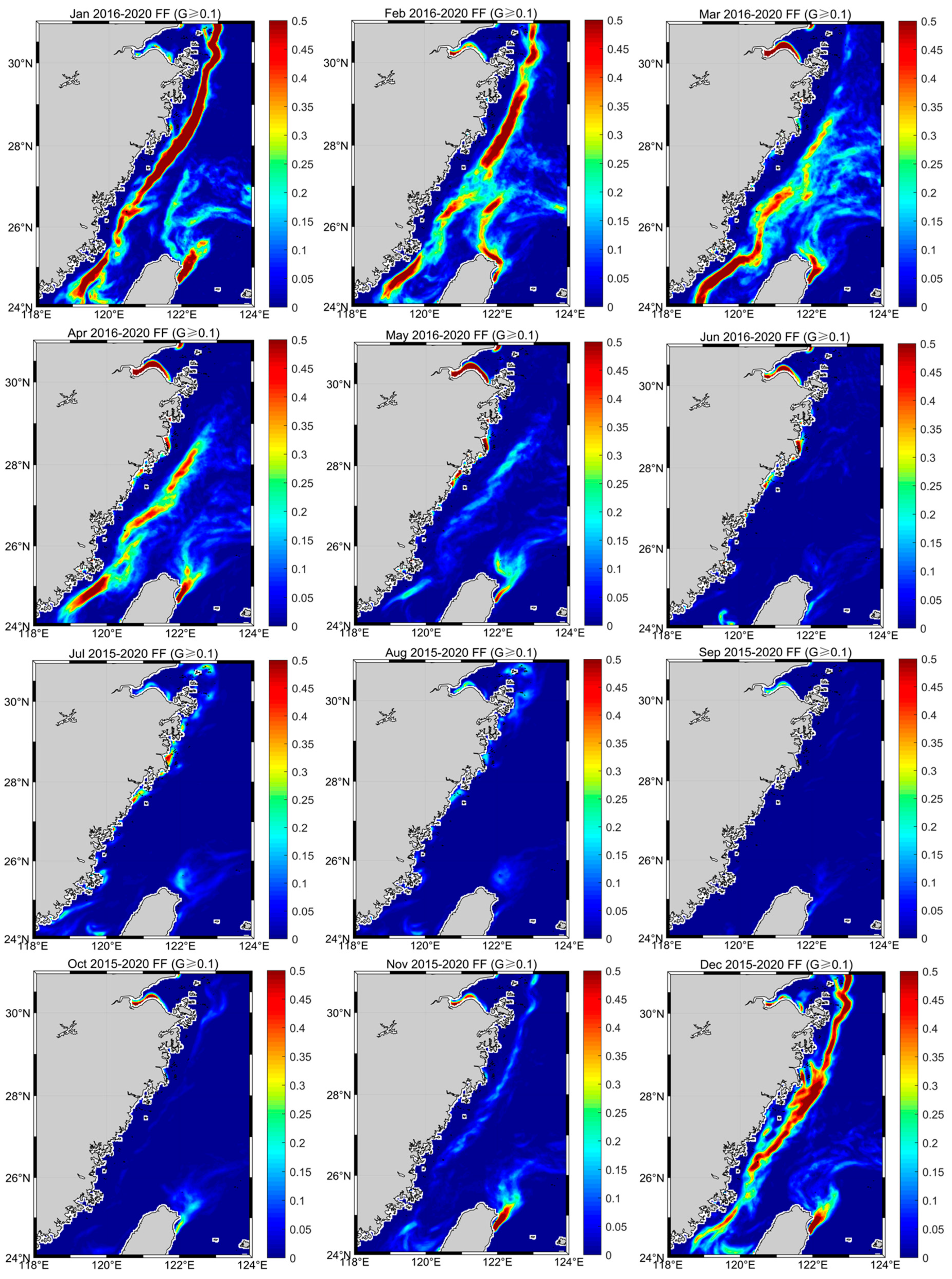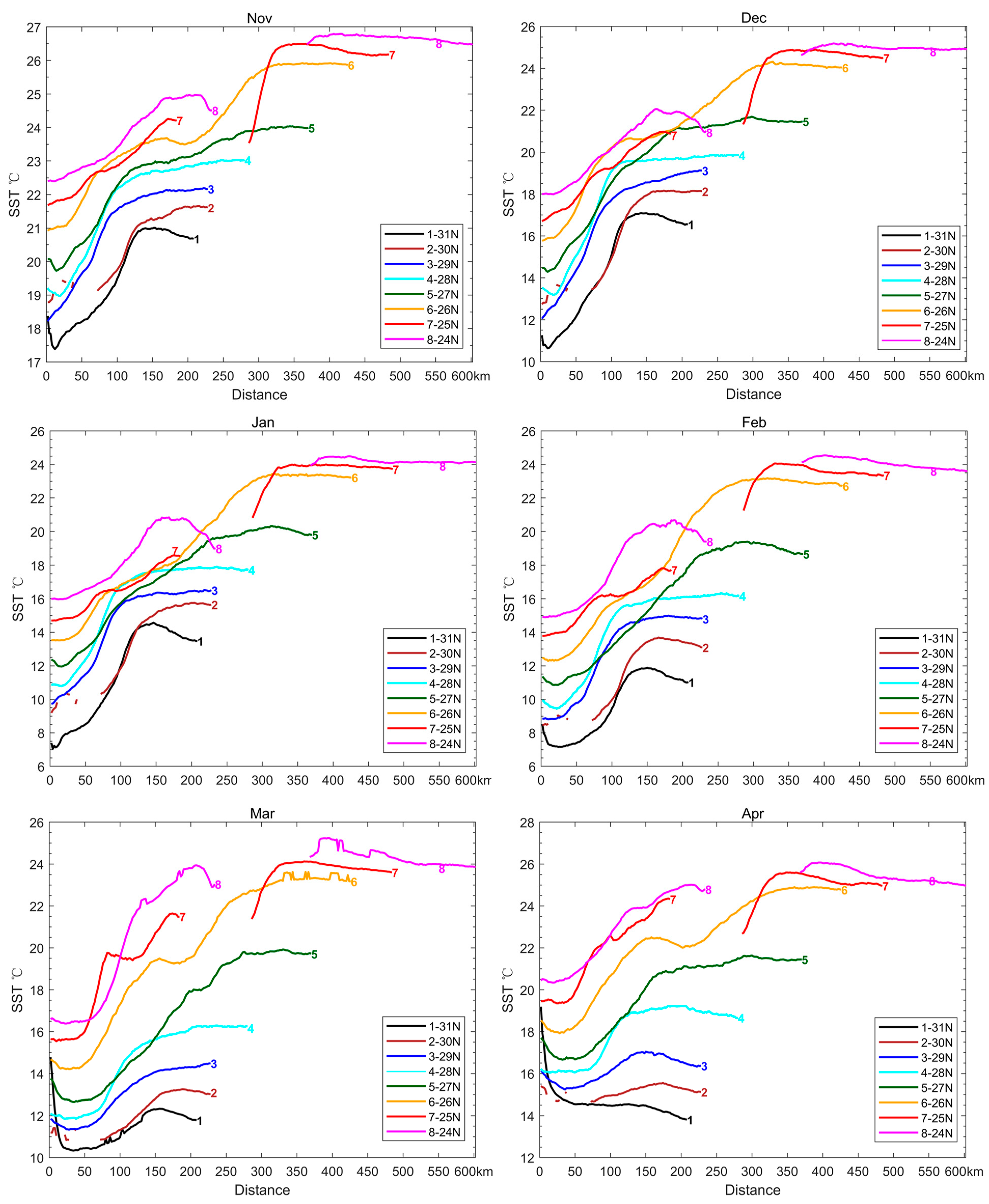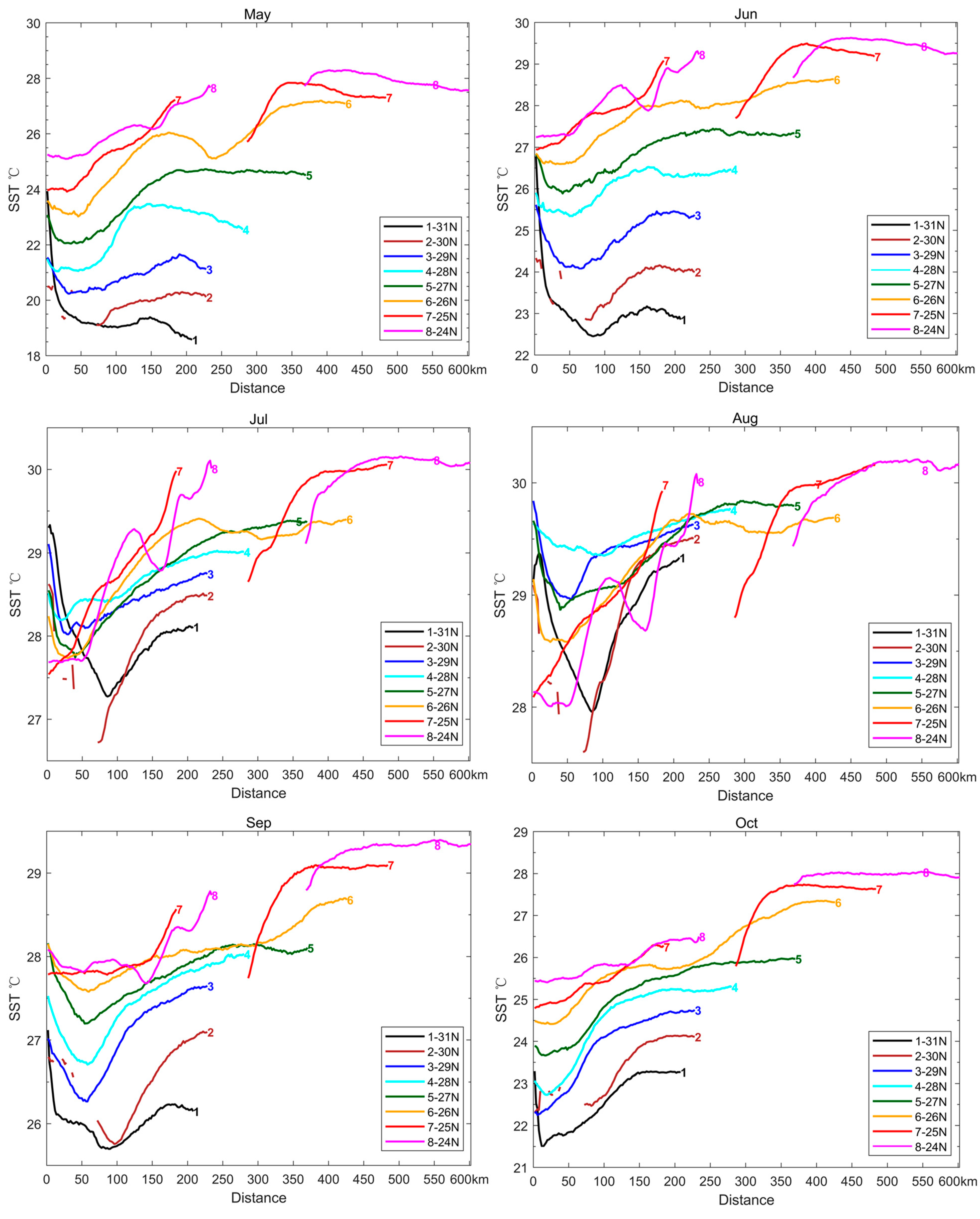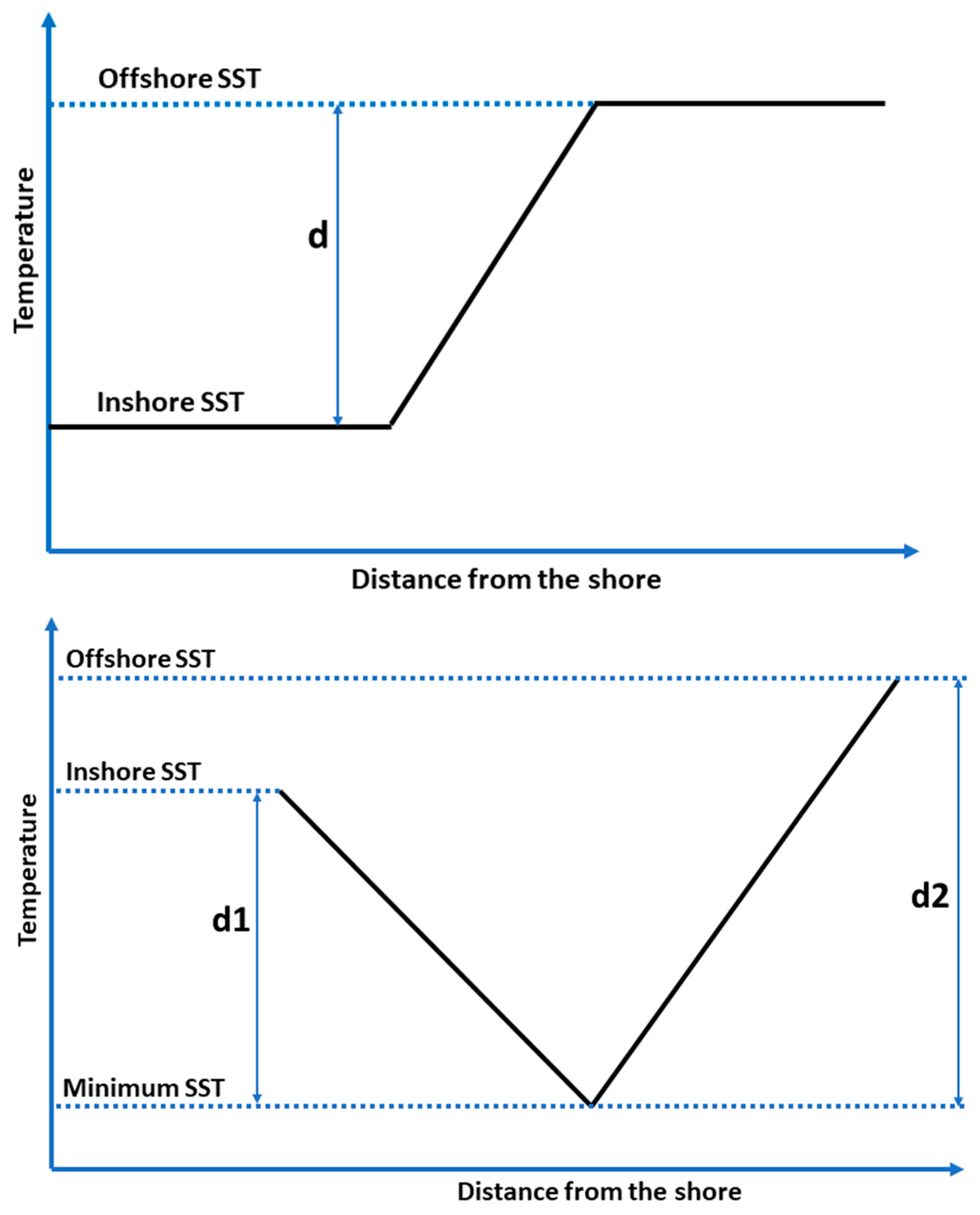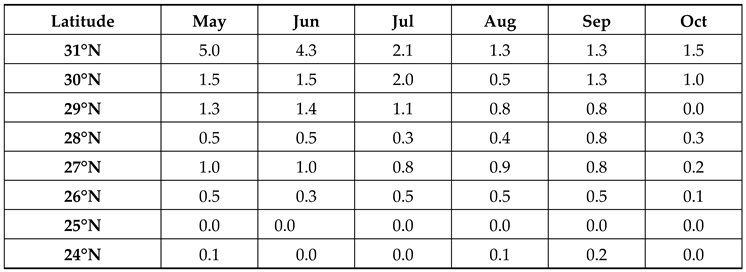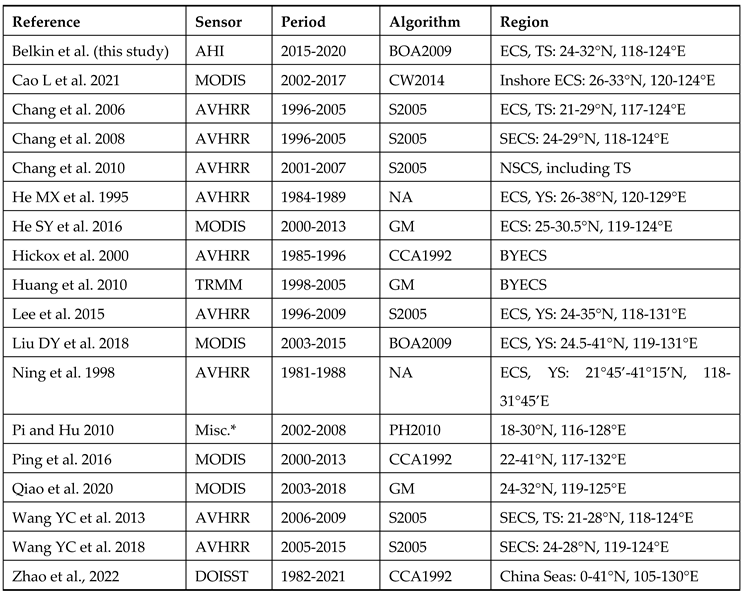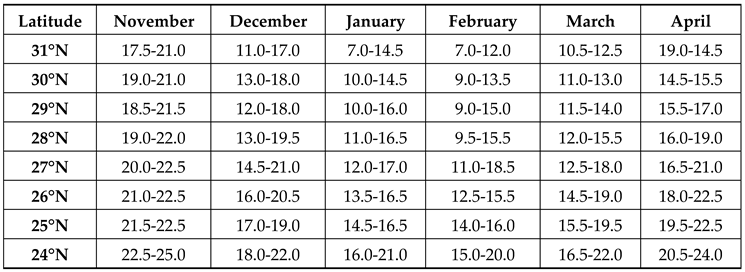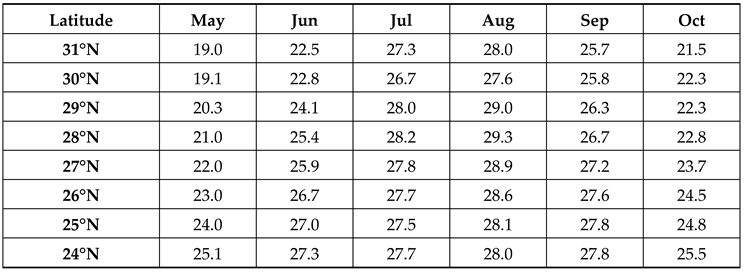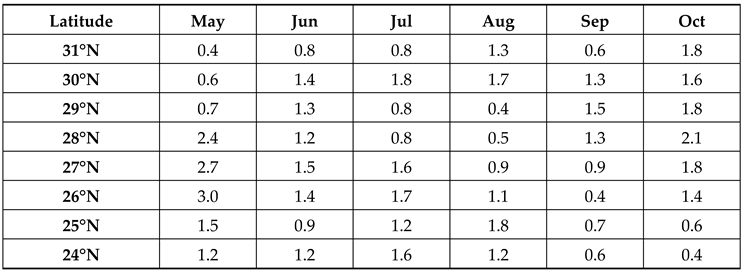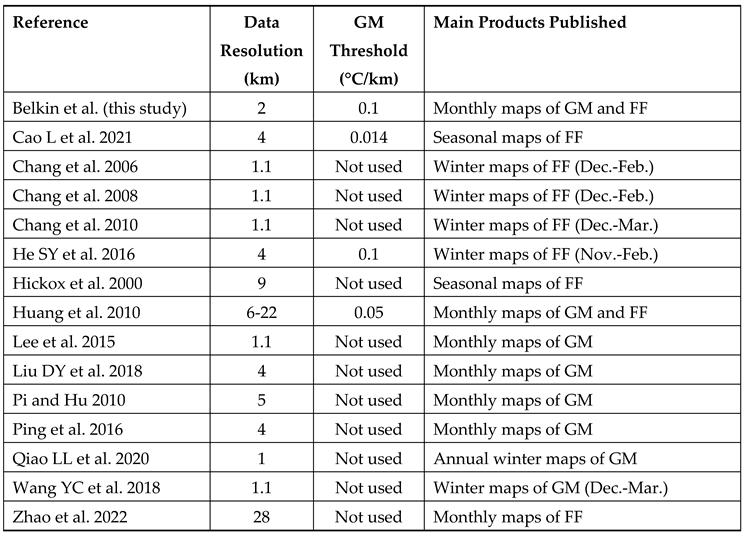1. Introduction
The China Coastal Current (CCC) is the most robust large-scale circulation feature in the East China Seas. The spatial stability of the CCC stems from the strong topographic control exerted by the coast and shallow bathymetry of the shelf. Even though the CCC reverses its direction twice a year following the seasonal monsoons, the CCC location over the inner shelf remains remarkably stable. Because of its proximity to the coast heavily populated by several hundred million people that live and work in the most economically advanced provinces of China, the CCC and associated ocean front (China Coastal Front, CCF) are of tremendous importance to various maritime activities such as fisheries, aquaculture, transportation, tourism, recreation, human health, weather/climate forecasts etc. Despite the paramount importance of the CCC and CCF, dedicated studies of the CCC and CCF are relatively rare. Most studies on the East China Sea and southern Yellow Sea focused on offshore circulation and fronts over middle and outer shelf (50-200 m depth), reviewed recently by Liu ZQ et al. (2021). In situ studies of inshore oceanography of this region are logistically challenging due to the shallow bathymetry of the inner shelf, where the rugged coastline and myriads of small islands complicate ship surveys. Satellite observations are free from the above logistical constrains. Since the advent of satellite oceanography, the CCF was studied from remote sensing data, first and foremost from sea surface temperature (SST) data.
Table 1 sums up a provisional inventory of remote sensing studies of the CCF from SST data. These studies elucidated many important aspects of the CCF discussed below and provided a solid background for the present study. In the following chronological review of previous investigations, we cite various names used by different researchers for the CCF such as the Zhejiang Front, Zhejiang-Fujian Front, Fujian-Zhejiang Front, Zhe-Min Front, Min-Zhe Front, and Mainland China Coastal Front. Within the ECS, these names are considered synonyms unless indicated otherwise.
The research-quality SST data provided by the Advanced Very High Resolution Radiometer (AVHRR) flown on NOAA polar-orbiting satellites and processed under the Pathfinder project (Minnett et al., 2019) became available since 1982 and were used in numerous studies. He MX et al. (1995) used AVHRR SST data from 1984-1989 to identify 8 fronts in the East China Sea and Yellow Sea, including the Zhejiang coastal front between 26°N and 29°N, offshore of the 50-m isobath, having a width of 10-50 km and a maximum SST gradient of 0.9 °C/km (
ibid.,
Figure 1 and
Table 1). The authors pointed out that this front “exists throughout the year but has different causes between winter and summer. In winter, it is an interface between the Zhejiang coastal water diluted from the Changjiang River and the warm saline water of the TWC [Taiwan Warm Current]. Its shape, off-shore distance and horizontal SST gradient are basically determined by the variability of the TWC. In summer, the enhancement of the local upwelling interacts with the permanent TWC, giving rise to a visible surface manifestation of this front.” (
ibid., p. 276). The authors noted (
ibid., p. 284) that in summer a “prominent upwelling zone is located between 25-30°N. The upwelled surface water is 5°C lower than the SST of the TWC.” Regarding the physical nature of the Zhejiang upwelling, they wrote (
ibid., p. 286): “There have been controversies over the major cause of this upwelling … One argument states that the upwelling is primarily caused by the upward climbing of the north residual of the Kuroshio and therefore is a permanent upwelling throughout the year. Another argument suggests that the upwelling is only generated by wind in summer and therefore is a seasonal upwelling.” The dual nature of the CCF has been addressed by numerous scholars and is discussed below.
Ning et al. (1998) used SST data from 1981-1986 and ocean color data from 1978-1986 to describe water masses and fronts in the ECS. Their maps of long-term monthly mean SST reveal wintertime development and summertime disappearance of the Min-Zhe coastal front along the 50-m isobath. Oddly, the monthly SST maps by Ning et al. (1998) do not show the Min-Zhe front until January, unlike those in other studies that show this front as early as October. The low resolution (18 km x 18 km) of the SST data used by Ning et al. (1998) may be accountable for the above discrepancy. Indeed, according to later studies cited below, in early winter the newly formed Min-Zhe current clings to the China coast, extending SW over very shallow water depths of 20 m or even less. Therefore, it is possible that the 18-km resolution SST data used by Ning et al. (1998) did not resolve the narrow Min-Zhe current in early winter until the current widened and shifted offshore by mid-winter.
Hickox et al. (2000) processed 9-km resolution, twice-daily Pathfinder AVHRR SST data from 1985-1996 with the Cayula and Cornillon (1992) algorithm (CCA), which detects SST fronts. Hickox et al. (2000) identified 10 fronts and determined long-term mean positions of their boundaries (offshore and inshore) from frontal frequency (FF) maps. Using maps of frontal frequency based on the BOA front detection output, Hickox et al. (2000) delineated frontal envelopes (or frontal corridors) consisting of inshore and offshore boundaries of each front and calculated long-term mean monthly SST averaged along each boundary, designated as Offshore SST and Inshore SST. Long-term mean monthly cross-frontal SST ranges (steps) were calculated as DT = Offshore SST – Inshore SST. Among other fronts, Hickox et al. (2000) distinguished the CCF, termed the Zhejiang-Fujian front, and emphasized its nature as a wintertime front best developed from December through March.
In a series of papers spanning a decade, Yi Chang and collaborators used the Shimada algorithm (Shimada et al., 2005) to detect SST fronts in the northern South China Sea and East China Sea (Chang et al., 2006; Chang et al., 2008; Chang et al., 2010; Lee et al., 2015). In a study of winter fronts in the Taiwan Strait and southern ECS, Chang et al. (2006) and Chang et al. (2008) used high-resolution (0.01°) AVHRR SST data from 1996-2005 to generate long-term monthly mean maps of SST gradient magnitude (GM) that revealed four major fronts, including the Mainland China Coastal Front (MCCF) along the 50-m isobath. The SST GM increases from December through February, when three local maxima of GM become distinct at 24.0-25.0°N, 26.5-27.0°N and 27.5-28.5°N (
ibid., p. 2 and
Figure 2). A local minimum of SST GM near 25.5-26.0°N is hypothetically ascribed to the impact of the Min River (Fujian) (Chang et al., 2008), which discharges on average 2,000 m
3/s at 26°N (
https://en.wikipedia.org/wiki/Min_River_(Fujian), retrieved 2022-08-27). Using 1-km SST data from 2001-2007, Chang et al. (2010) generated detailed maps of frontal frequency FF for December through March. In December and January, the continuous MCCF extends along the Fujian and Guangdong coasts up to Hainan. However, in February and March, the MCCF south of 25°N does not continue along the Fujian coast. Instead, the MCCF veers offshore to join the Taiwan Bank Front (TBF) located along the steep southern flank of the Bank. The MCCF-TBF merger was noted earlier by Wang DX et al. (2001), Chang et al. (2006), and Chang et al. (2008). In a follow-up paper based on 1-km 1996-2009 SST data, Lee et al. (2015) published long-term mean monthly maps of SST GM (
ibid., Figs. 2 and 3) that reveal heretofore unreported details of the MCCF’s space-time variability. Contrary to most previous studies that placed this front either along the 50-m isobath or offshore of this isobath (He MX at al., 1995), the monthly maps of GM in Lee et al. (2015) clearly portray the MCCF well
inshore of the 50-m isobath during the entire 8-month period of the front’s visibility in SST data (September through April). Moreover, when the front emerges in September off of the Zhejiang coast, it is located
inshore of the 20-m isobath! (
ibid.,
Figure 3C). As the season progresses, the front shifts into deeper waters, where it is found over the 20-m isobath in October-December and between the 20-m and 50-m isobaths in January-March and possibly through May.
Meanwhile, Huang et al. (2010) used the all-weather capability of the Tropical Rainfall Measuring Mission (TRMM) microwave imager (TMI) to study SST fronts in the YS and ECS from the 1998-2005 swath data with a resolution of 6 to 22 km (as opposed to the standard TMI gridded data with 0.25° x 0.25° resolution that were considered too coarse for gradient calculation). Among five coastal fronts around the YS and ECS, Huang et al. (2010) identified the Zhe-Min front, which exists from December through May, peaking in February in terms of frontal gradient magnitude GM and frontal frequency FF (for GM > 0.05°C/km). The results obtained by Huang et al. (2010) are remarkably consistent with those by Hickox et al. (2000) despite different satellite sensors, observation periods, and front detection algorithms used in these studies.
Pi and Hu (2010) studied SST fronts of the ECS and NSCS by combining various satellite data (AVHRR, MODIS, and AMSR-E) from 2002-2008 and processing this data set with a novel algorithm for mathematical morphology-based edge detection in satellite imagery. Among other fronts, the Zhe-Min Coastal Front was identified that develops in winter, peaks in April, and disappears in summer. The peak time in April is different from other studies that found the peak time in February-March. The overall pattern of seasonal evolution of the Zhe-Min Front is also qualitatively different from other studies. Although the 0.05° x 0.05° resolution (roughly 5 km) can be considered adequate for such a study, the monthly maps of frontal gradient GM in Pi and Hu (2010) appear smoothed out, which might have resulted from interpolation and smoothing applied during data reprocessing (ibid., p. 1009).
Wang YC et al. (2013) combined in situ data (repeat CTD sections) and satellite SST imagery to describe the China Coastal Current Front in the southern ECS and Taiwan Strait. The SST imagery from Decembers 2006-2009 reveal the fully developed cold CCC (with SST as low as 15°C) by the end of December, while CTD data from repeat quasi-zonal sections along K Line (slant line along ~26°N) document the low-salinity (down to 30 ppt) signature of the CCC. The shallowest station (K1, 26.17°N, 120.08°E) was occupied in water depth exceeding 30 m, which illustrates bathymetric constrains that prevent ship surveys in shallow waters (<30 m). Obviously, remote sensing is not constrained by navigational hazards that impede in situ sampling of near-shore waters. Satellite imagery is especially advantageous in case of the CCC because the CCC hugs the China coast, often extending over very shallow depths (<30 m) as evidenced by CTD sections and SST maps presented by Wang YC et al. (2013). In a follow-up study, Wang YC et al. (2018) used 1-km resolution AVHRR SST data from 2005-2015 to study fronts in the SECS in winter (December through March). The Mainland China Coastal Front (MSSF) persisted along the 50-m isobath, coincident with the 14-16°C/km isotherms. The frontal SST GM of 0.20-0.40°C/km was substantially higher vs. the SST GM of 0.14°C/km in 1996-2009 (Lee et al., 2015). However, any estimates of gradients are critically dependent on data resolution and details of data processing such as gridding, smoothing etc.
Lately, researchers began using MODIS SST data that became available from 2000 onward. He SY et al. (2016) used 4-km resolution MODIS data from 2000-2013 to document a previously unreported wintertime (December-January) front along the 20-m isobath offshore the Zhe (Zhejiang) and Min (Fujian) coasts, inshore of the well-known Zhe-Min Coastal Front along the 50-m isobath. The inshore front extends from 26.5-29.5°N in December and 28.0-29.5°N in January, being relatively narrow (4-16 km) compared with the offshore front (16-48 km). He SY et al. (2016) stressed the important role of local bathymetry in the frontogenesis of both fronts. In particular, the shallow (depth < 20 m) inshore portion of the shelf widens due north, from nearly 0 km at 26.5°N up to 50 km at 29.5°N (
ibid.,
Figure 2). In the northern part of this wedge-shape area (north of 28.5°N), the SST in January 2007 was as low as 10°C or less (
ibid.,
Figure 1a). It seems the localized inshore cooling in this shallow area may help create a thermal east-west gradient that manifests as the inshore front.
Liu DY et al. (2018) processed 4-km resolution MODIS SST data from 2003-2015 with the Belkin and O’Reilly (2009) algorithm (BOA) to map 10 fronts between 24°N and 41°N, the same fronts as in Hickox et al. (2000). The Zhejiang-Fujian Front emerges in September offshore the Zhejiang coast; the front then grows southward and strengthens through February; then it gradually shrinks, weakens, and eventually disappears from March through August. During its maximum development in winter (December-February) the front extends north up to 32°N, where its connection to the Jiangsu Front (Hickox et al., 2000) is tenuous at best.
Qiao LL et al. (2020) used MODIS SST data from 2003-2018 to map fronts in the ECS and study their relation to the distribution of suspended sediments. This study is notable for bringing in a massive amount of in situ data collected during numerous shipborne CTD surveys. The Zhe-Min Coastal Front plays an important role by trapping most sediments. The sediment trapping by the front explains a dramatic cross-front gradient of the mud layer thickness: from 40 m underneath the front to just a few meters outside it. Qiao LL et al. (2020,
Figure 7) presented 16 maps of SST gradient magnitude for individual winters 2003-2018. These maps reveal strong interannual variations of the Zhe-Min Coastal Front and smaller fronts in its vicinity. In particular, the inshore front along the 20-m isobath (He SY et al., 2016) manifests exceptionally well in winter 2005. While some interannual variations may be artifacts that are accounted for by interannual variation of cloudiness, major interannual variations in SST GM maps published by Qiao LL et al. (2020,
Figure 7) are likely real.
Wang YT et al. (2020) processed 4.5-km resolution MODIS SST data from 2002-2017 with a novel front detection algorithm to study fronts in the SCS, including the Taiwan Strait up to 25°N. The seasonal variability and spatial pattern of SST fronts in the NSCS and Taiwan Strait reported by Wang YT et al. (2020) appear very similar to those in Chang et al. (2006), Chang et al. (2008), Chang et al. (2010), and Lee et al. (2015).
Cao L et al. (2021) processed 4.5-km resolution MODIS SST data from 2002-2017 with the Castelao and Wang (2014) algorithm to map fronts in the western ECS. Even though the 4-km resolution of the data used is not considered “high-resolution” these days, the frontal maps in Castelao and Wang (2014) reveal the ECS fronts in unprecedented detail. The inshore front north of 26.5°N (He SY et al., 2016) is identified in long-term mean maps of frontal gradient magnitude GM and frontal probability FP (Cao L et al., 2021,
Figure 2 and
Figure 3). A relatively weak but robust SW-NE front across the Hangzhou Bay stands out year-around in FP maps (
ibid.,
Figure 2a and
Figure 3) despite being barely noticeable in the GM map (
ibid.,
Figure 2b). A peculiar but stable double-front structure of the Zhe-Min front is observed between 31-33°N, where the front is split in two branches that are best defined in October-December (
ibid.,
Figure 3a).
Zhao et al. (2022) applied the Cayula-Cornillon algorithm (CCA) to detect SST fronts in the China Seas (0-41°N, 105-130°E) using the NOAA 1/4° DOISST (Daily Optimum Interpolation SST) data set. Despite the relatively poor spatial resolution of the SST data (0.25° x 0.25°), Zhao et al. (2022) were able to detect all fronts identified by Hickox et al. (2000) and Wang DX et al. (2001) and provided monthly maps of GM based on the longest SST record to date (1982-2021).
The above studies elucidated the main features of space-time variability of the CCF. However, in most studies to date, the CCF was just a single element of a complicated frontal pattern of numerous fronts (e.g., Park and Chu, 2006; Chen, 2009; Zhao et al., 2022). After the seminal study by Hickox et al. (2000) that included a rudimentary climatology of the CCF alongside other fronts, there were no attempts to produce a comprehensive satellite data-based climatology of the CCF. In the present paper, we set out to fill this gap. In particular, save for the rudimentary climatology by Hickox et al. (2000), the cross-frontal range of SST and its seasonal and along-stream variations have not been studied. Instead, researchers focused on SST gradients. Meanwhile, it’s the cross-frontal SST range (or step) that plays a crucial role in marine ecology (Belkin, 2021). The importance of this parameter is amplified by the ongoing climate change. Other aspects of the CCF that remain elusive are its interannual variability, especially with regard to river discharge and wind forcing, and the CCF association with regional bathymetry and geomorphology.
Another objective of this study is the evaluation of data provided by the AHI flown aboard the Himawari-8 geostationary satellite, specifically the evaluation of the AHI/Himawari potential for satellite studies of ocean fronts in the China Seas. Most Earth-observing satellites are placed into sun-synchronous orbits that allow a nearly complete global coverage in a relatively short time (1-2 days), with each location observed twice a day. Geostationary satellites, in principle, allow extremely frequent observations of the same locations, with sampling frequency being only constrained by the sensor’s parameters (scanning speed) and not constrained by the satellite orbit. Therefore, geostationary satellites are uniquely suited for observations of high-frequency phenomena in the ocean, including high-frequency variability of currents and fronts.
The rest of this paper is structured as follows:
Section 2 describes AHI/
Himawari-8 data and methods of data processing, including front detection and mapping.
Section 3 presents results of data processing, particularly a collection of maps and graphs that document the spatial and temporal variability of the CCF.
Section 4 is dedicated to a careful comparison with previous results; it also includes a brief discussion of most salient (or controversial) issues.
Section 5 sums up our main results and draws conclusions.
2. Data and Methods
The Japanese geostationary meteorological satellites
Himawari 8/9 (
himawari means
sunflower in Japanese) represent a major advancement in remote sensing of our planet (Bessho et al., 2016). Both satellites carry the Advanced Himawari Imager (AHI) that has 16 spectral bands, including 3 visible light bands (#1-3), 3 near-infrared bands (#4-6) and 10 infrared bands (#7-16). The AHI’s spatial resolution is 2 km for bands #5-16; 1 km for bands #1, 2, and 4; and 500 m for band #3. The AHI provides a full disk imagery every 10 mins. Cloud-free SST composites of the full disk are available every 4 days. Owing to their location at 140.7°E and coverage range of 80°E-160°W, 60°N-60°S, these satellites are well suited for satellite studies of the China Seas. Thanks to the AHI characteristics, its data are widely used for studies of various oceanic processes, including fronts and their high-frequency variability (e.g., Hu ZF et al., 2022). The Himawari-8 satellite has been launched by the Japan Meteorological Agency (JMA) on 7 October 2014 and became operational on 7 July 2015. In this study, L3 level SST data with a temporal resolution of 1 hour and a spatial resolution of 2 km from July 2015 to December 2020 that cover our study area (24-32°N, 118-124°E) were downloaded from the P-Tree system website operated by the Japan Aerospace Exploration Agency, JAXA (
https://www.eorc.jaxa.jp/ptree/). The hourly data are generated by the JAXA from the original 10-minute data. The AHI data set benefits from a radically improved cloud-masking algorithm, which takes advantage of high-resolution (500 m) visual imagery that resolves individual cumulus clouds (Bessho et al., 2016). Combined with a novel cloud-tracking algorithm and high frequency of full disk scanning (every 10 min.), this enables the production of cloud-free imagery every 4 days, which is unprecedented.
To map SST fronts associated with the CCC, we used the BOA algorithm (Belkin and O’Reilly, 2009) that generates maps of gradient magnitude (GM) and gradient direction (GD). The BOA does not generate frontal maps. Instead, a BOA user can set a GM threshold T, so that every pixel with GM>T is considered a frontal pixel. A map showing GM at frontal pixels (where GM>T) is considered a frontal map. The selection of T is inherently arbitrary. Therefore, we ran experiments with several different values of T before we have selected a particular value of T (0.1°C/km), which deemed most suitable for frontal maps. The overall frontal pattern in the study area appears quite robust and not overly sensitive to the actual choice of T.
Once frontal maps are generated, a statistical study of fronts is commenced. Following the statistical approach pioneered by Cayula and Cornillon (1992), pixel-based maps of frontal frequency FF are generated. For each pixel (array element with indices i,j), pixel-based frontal frequency FF(i,j)=N(i,j)/N(cloud-free), where N(i,j) is the total number of times the given pixel was frontal (that is GM(i,j)>FG) while N(cloud-free) is the total number of times the given pixel was cloud-free. Thus, a pair of maps of a given area – a map of GM and a map of FF – provides a complete high-resolution (pixel-based) characterization of fronts within the mapping area with two radically different and complementary metrics: gradient magnitude GM, which is a metric of front’s sharpness (or intensity) and frontal frequency FF, which is a metric of front’s stability (or robustness). Neither metric, however, reflects another important aspect of every front, which is front’s strength defined as the total cross-frontal range (or cross-frontal step or change) of the oceanic variable in question.
In satellite oceanography, cross-frontal ranges were systematically estimated in a pioneering study by Hickox et al. (2000), who investigated seasonal variability of ten SST fronts in the East China, Yellow, and Bohai Seas. Using monthly maps of frontal frequency FF, Hickox et al. (2000) delineated offshore and inshore boundaries of the 10 fronts and calculated long-term mean monthly SST along each boundary. Thus, for each front, a pair of long-term monthly mean SST (designated as Offshore SST and Inshore SST) characterizes the cross-frontal SST range during the given month, which is calculated as a difference between these two values: SST Range = Offshore SST – Inshore SST. Of 10 fronts studied by Hickox et al. (2000), eight fronts are rather short; in such cases along-front averaging is justified. However, two other fronts (Kuroshio and CCF) are rather long; in such cases cross-frontal SST ranges are expected to change along-stream. In this study we explored the along-stream variability of monthly SST ranges across the CCF and produced a complete space-time SST climatology of the CCF.
The 10-minute and hourly SST data provided by AHI allow high-frequency phenomena (e.g., rapid development of frontal meanders and formation of frontal eddies and rings) to be investigated. The below sample of three hourly datasets (
Figure 1) illustrates the potential of hourly data. The CCF, Kuroshio and other offshore fronts in-between (located over depths exceeding 30 m) are reproduced in each dataset, appearing fairly identical in terms of location, shape, and gradients. Conversely, numerous inshore shallow fronts between the coast and CCF (located over depths of less than 30 m) vary at the hourly scale by changing their location, shape, and gradient. Such rapidly varying shallow fronts can be studied from high-frequency data generated by AHI at
Himawari-8/9.
The main temporal scale addressed in this study is seasonal. The CCC and associated CCF are known to develop during the winter monsoon and degenerate during the summer monsoon. Monthly data adequately resolve the seasonal monsoon-driven variability of the current and front. Our data processing started with hourly SST data that were processed with the BOA to generate maps of frontal gradient magnitude GM that were used to generate maps of frontal frequency FF for individual weeks, months, and years, and for long-term mean months (2015-2020) and years (2016-2020) as illustrated in
Figure 2 and
Figure 3. Since this study is focused on the seasonal variability of CCF, monthly maps of GM and FF served as a main instrument in data analysis. We also paid attention to interannual variations; however, the limited length (<6 years) of the AHI dataset precludes a rigorous study of interannual variability, which will become possible after addition of
Himawari-9 data, to be collected over 2022-2030.
Figure 1.
Sample hourly data from 27 October 2018. Top row: SST (°C). Bottom row: SST gradient magnitude GM (°C/km). Offshore fronts, including the CCF and Kuroshio branches, do not change their location, shape, and gradient at the hourly scale, while many inshore shallow fronts vary appreciably over hourly intervals.
Figure 1.
Sample hourly data from 27 October 2018. Top row: SST (°C). Bottom row: SST gradient magnitude GM (°C/km). Offshore fronts, including the CCF and Kuroshio branches, do not change their location, shape, and gradient at the hourly scale, while many inshore shallow fronts vary appreciably over hourly intervals.
Figure 2.
Sample data sets illustrating daily (top row), weekly (middle row) and monthly (bottom row) data. Each data set consists of SST (°C; left), SST gradient magnitude GM (°C/km; center), and frontal frequency FF at GM>=0.1°C/km (right).
Figure 2.
Sample data sets illustrating daily (top row), weekly (middle row) and monthly (bottom row) data. Each data set consists of SST (°C; left), SST gradient magnitude GM (°C/km; center), and frontal frequency FF at GM>=0.1°C/km (right).
Figure 3.
Sample long-term mean data for January 2016-2020. Left: SST (°C). Center: SST gradient magnitude GM (°C/km). Right: Frontal frequency FF at GM>=0.1 °C/km.
Figure 3.
Sample long-term mean data for January 2016-2020. Left: SST (°C). Center: SST gradient magnitude GM (°C/km). Right: Frontal frequency FF at GM>=0.1 °C/km.
